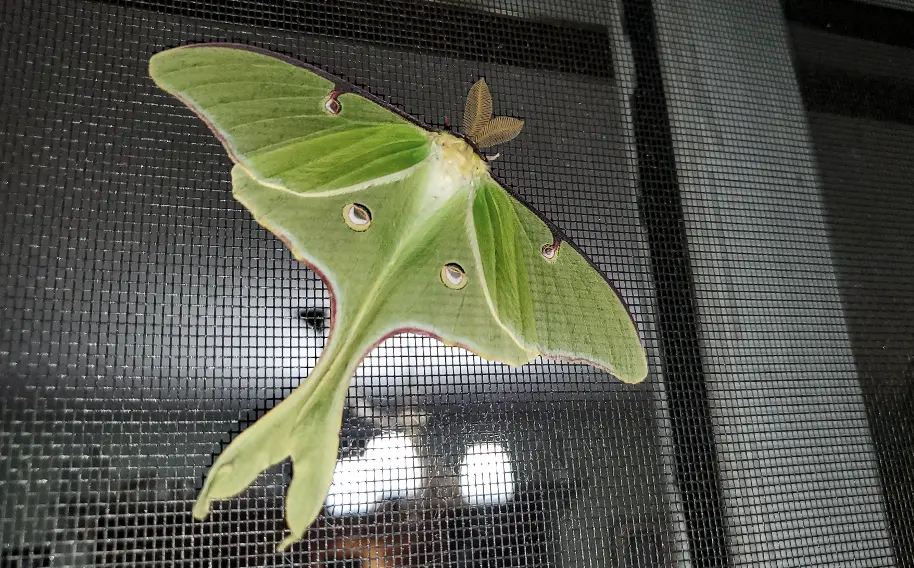By Frank Gallo
It is the middle of the night in the Spring of 1964. A small boy stands in a doorway staring in awe at a creature silhouetted against the shade of his parents’ bedroom window. Clinging to the screen, in the light of the corner streetlamp, is a giant pastel green moth with long tail streamers. Unaware of the boy, it rhythmically flexes its wings to the pulse of its own needs. Perhaps it is a female in search of a mate slowly wafting her scent on the breeze or a male resting before pursuing a female, scented, perhaps at great distance, by his delicate fern-like antennae. At the time, the boy cares nothing about the answers to these mysteries. He was merely a child filled with wonder by the rare and delicate beauty of a luna moth. Little does he realize how rare this sight would soon become. He would not see another for more than 30 years. But he would always remember.

The luna moth, Actias luna, is a member of the giant silkworm family, Sturnidae, the same subfamily as the striking polyphemus moth. Lunas occur in every state east of the Great Plains, and from Canada southward through Mexico and into Central America. They are creatures of deciduous woodlands and are also seen in suburban and urban areas with suitable habitat. Lunas are common in many parts of their range, especially in the south where they are double brooded. They have become uncommon to rare in many parts of Connecticut for reasons not completely understood. Aerial spraying of pesticides to control spongy (gypsy) moths in the 1960’s, 70’s, 80’s has been posited as a major cause, evidenced by the luna moths continued common presence on unsprayed coastal islands during this period. Habitat loss has also played a part. Others argue that non-host-specific insect parasites, such as the fly Compsitura concinnata and other flies and wasps released by the government to attack spongy moths, also attack and kill luna and other large moths, devastating their populations. Could the ravenous spongy moth caterpillars themselves have outcompeted the other large moths, contributing to their demise. Repeated defoliation by spongy moths certainly reduced the amount of available food in specific areas. Whatever the reasons, luna moths have been scarce or absent in many areas of the state, and with them have gone the large, night flying moth- eaters, Eastern Whip-poor-wills, Common Nighthawks and even some bats. Recently, however, more frequent reports, especially in the past few years, may indicate some recovery in our area.
After hatching, the male luna moth spends three weeks of the fall munching hickory leaves to store energy for adulthood, before pupating at the base of the hickory tree by creating a silken cocoon hidden in the leaflitter in which to over winter. After emerging from his cocoon in spring, he expands and dries his wings then goes in search of a mate. The “ugly duckling” caterpillar has become a beautiful moth, but one without working mouth parts. Unlike many of his close relatives, he cannot sip nectar to replenish his energy. His stored reserves from the fall will have to sustain him on his mating quest. He will only have a week or so to reproduce and pass on his genes to the next generation. Less time if he is discovered by a predator. It will have to suffice.
After three nights of flying in search of a female much of his strength is gone. In two or three more nights the last of his reserves will be spent and he will die. Will it be enough time to mate? The scent of a female reaches him on the breeze…
All that remained were apple-green wings edged in pink, scattered beneath the porch light like rose petals before an emperor. Remains of moths attracted to the glow of a false moon, only to die, in the mouth of a predatory screech owl, nighthawk or bat, or to burn on the surface of this attainable “sun”, their bodies singed, and their wings strewn onto the earth below. Although he had not yet seen one alive, the naturalist remained pleased, for the wings were proof that luna moths were alive at the Nature Center.
It is a muggy May evening in 1995. A gas station attendant, in a quiet town in northern New Jersey, scoops up a fluttering green form from the pavement and places it on a gas pump away from immediate danger. He stares at it with a look of wonder and awe apparent on his face. A birding team of six from Connecticut piles out of a nearby van for a closer look. They too are struck by the beauty of this creature. It is a large moth with wings of a delicate pastel green, edged in pink, eye-spots fore and aft and hind wings sweeping gracefully into long tails. It is new to most in the group as it is rarely encountered in their home state. It is a beauty nearly lost in their area to the battle of the gypsy moth in the 60’s, 70 ‘s, and 80’s. It is Luna. The six men place it in the woods before speeding off to their destination. But with them, a small boy, now grown, remembers… a shape in the night silhouetted in the glow of a streetlight.
Frank Gallo is the Senior Naturalist at the New Canaan Nature Center, 144 Oenoke Ridge, and the author of Birding in Connecticut – a comprehensive site guide on where when and how to find birds in the State. Email: Fgallo@newcanaannature.org. For more on the New Canaan Nature Center, visit Newcanaannature.org.

